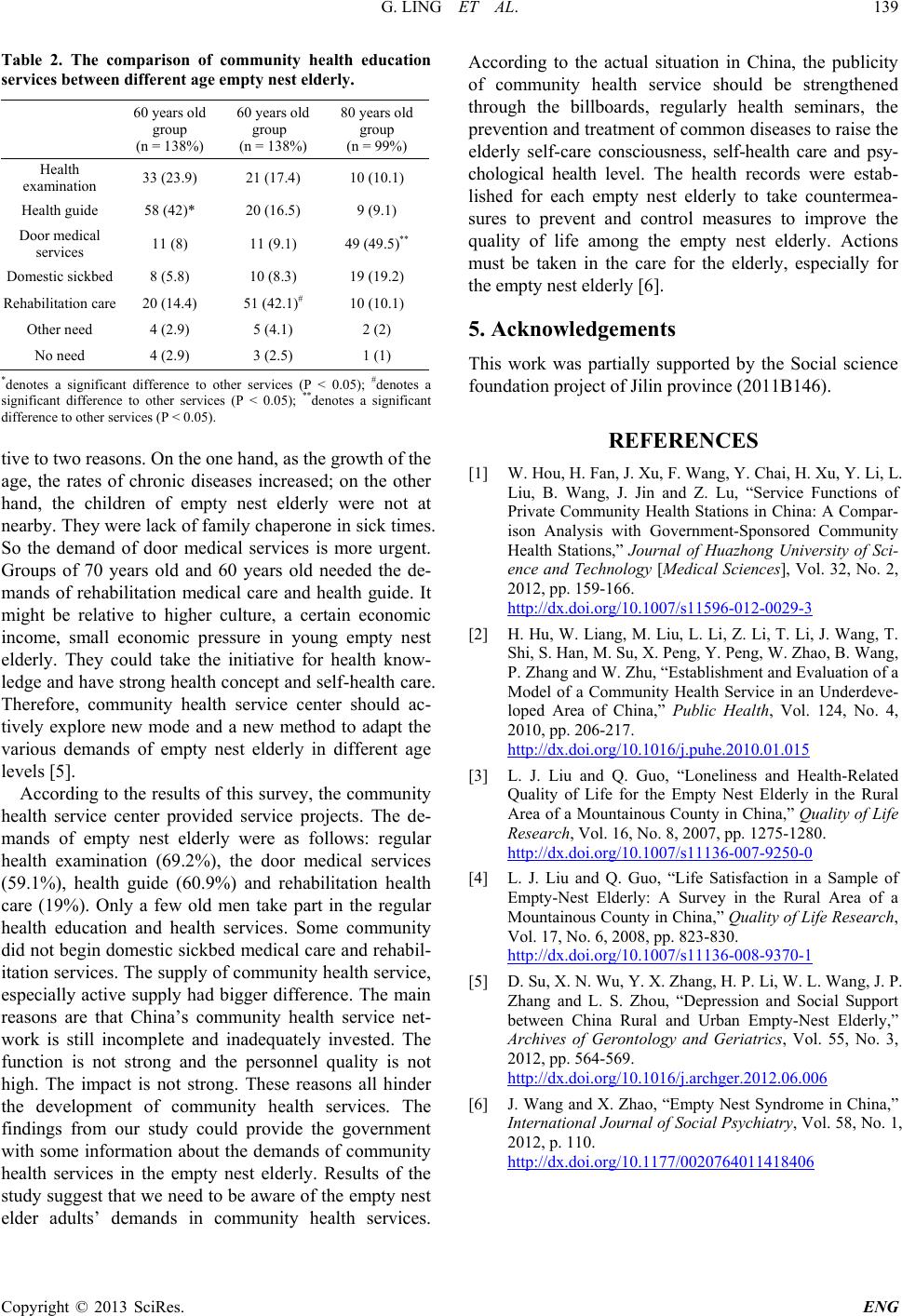
G. LING ET AL.
Copyright © 2013 SciRes. ENG
Table 2. The comparison of community health education
services between different age empty nest elderly.
60 years old
group (n = 138%)
60 years old
group (n = 138%)
80 years old
group (n = 99%)
Health
examination 33 (23.9) 21 (17.4) 10 (10.1)
Health guide 58 (42)* 20 (16.5) 9 (9.1)
Door medical
services 11 (8) 11 (9.1) 49 (49.5)**
Domestic sickbed
8 (5.8) 10 (8.3) 19 (19.2)
Rehabilitation care
20 (14.4) 51 (42.1)#
10 (10.1)
Other need 4 (2.9) 5 (4.1) 2 (2)
No need 4 (2.9) 3 (2.5) 1 (1)
*denotes a significant difference to other services (P < 0.05); #denotes a
significant difference to other services (P < 0.05); **denotes a significant
difference to other services (P < 0.05).
tive to two reasons. On the one hand, as the growth of the
age, the rates of chronic diseases increased; on the other
hand, the children of empty nest elderly were not at
nearby. They were lack of family chap erone in sick times.
So the demand of door medical services is more urgent.
Groups of 70 years old and 60 years old needed the de-
mands of rehabilitation medical care and health guide. It
might be relative to higher culture, a certain economic
income, small economic pressure in young empty nest
elderly. They could take the initiative for health know-
ledge and have strong health concept and self-health care.
Therefore, community health service center should ac-
tively explore new mode and a new method to adapt the
various demands of empty nest elderly in different age
levels [5].
According to the results of this survey, the community
health service center provided service projects. The de-
mands of empty nest elderly were as follows: regular
health examination (69.2%), the door medical services
(59.1%), health guide (60.9%) and rehabilitation health
care (19%). Only a few old men take part in the regular
health education and health services. Some community
did not begin domestic sickbed medical care and rehabil-
itation services. The supply of community health service,
especially active supply had bigger difference. The main
reasons are that China’s community health service net-
work is still incomplete and inadequately invested. The
function is not strong and the personnel quality is not
high. The impact is not stron g . These reasons all hinder
the development of community health services. The
findings from our study could provide the government
with some information about the demands of community
health services in the empty nest elderly. Results of the
study suggest that we need to be aware of the empty nest
elder adults’ demands in community health services.
According to the actual situation in China, the publicity
of community health service should be strengthened
through the billboards, regularly health seminars, the
prevention and treatment of common diseases to raise the
elderly self-care consciousness, self-health care and psy-
chological health level. The health records were estab-
lished for each empty nest elderly to take countermea-
sures to prevent and control measures to improve the
quality of life among the empty nest elderly. Actions
must be taken in the care for the elderly, especially for
the empty nest elderly [6].
5. Acknowledgements
This work was partially supported by the Social science
foundation project of Jilin province (2011B146).
REFERENCES
[1] W. Hou, H. Fan, J. Xu, F. Wang, Y. Chai, H. Xu, Y. Li, L.
Liu, B. Wang, J. Jin and Z. Lu, “Service Functions of
Private Community Health Stations in China: A Compar-
ison Analysis with Government-Sponsored Community
Health Stations,” Journal of Huazhong University of Sci-
ence and Technology [Medical Sciences], Vol. 32, No. 2,
2012, pp. 159-166.
http://dx.doi.org/10.1007/s11596-012-0029-3
[2] H. Hu, W. Liang, M. Liu, L. Li, Z. Li, T. Li, J. Wang, T.
Shi, S. Han, M. Su, X. Peng, Y. Peng, W. Zhao, B. Wang,
P. Zhang and W. Zhu, “Establishment and Evaluation of a
Model of a Community Health Service in an Underdeve-
loped Area of China,” Public Health, Vol. 124, No. 4,
2010, pp. 206-217.
http://dx.doi.org/10.1016/j.puhe.2010.01.015
[3] L. J. Liu and Q. Guo, “Loneliness and Health-Related
Quality of Life for the Empty Nest Elderly in the Rural
Area of a Mountainous County in China,” Qual ity of Life
Research, Vol. 16, No. 8, 2007, pp. 1275-1280.
http://dx.doi.org/10.1007/s11136-007-9250-0
[4] L. J. Liu and Q. Guo, “Life Satisfaction in a Sample of
Empty-Nest Elderly: A Survey in the Rural Area of a
Mountainous County in China,” Quality of Life Research,
Vol. 17, No. 6, 2008, pp. 823-830.
http://dx.doi.org/10.1007/s11136-008-9370-1
[5] D. Su, X. N. Wu, Y. X. Zhang, H. P. Li, W. L. Wang, J. P.
Zhang and L. S. Zhou, “Depression and Social Support
between China Rural and Urban Empty-Nest Elderly,”
Archives of Gerontology and Geriatrics, Vol. 55, No. 3,
2012, pp. 564-569.
http://dx.doi.org/10.1016/j.archger.2012.06.006
[6] J. Wang and X. Zhao, “Empty Nest Syndrome in China,”
International Journal of Social Psychiatry, Vol. 58, No. 1,
2012, p. 110.
http://dx.doi.org/10.1177/0020764011418406